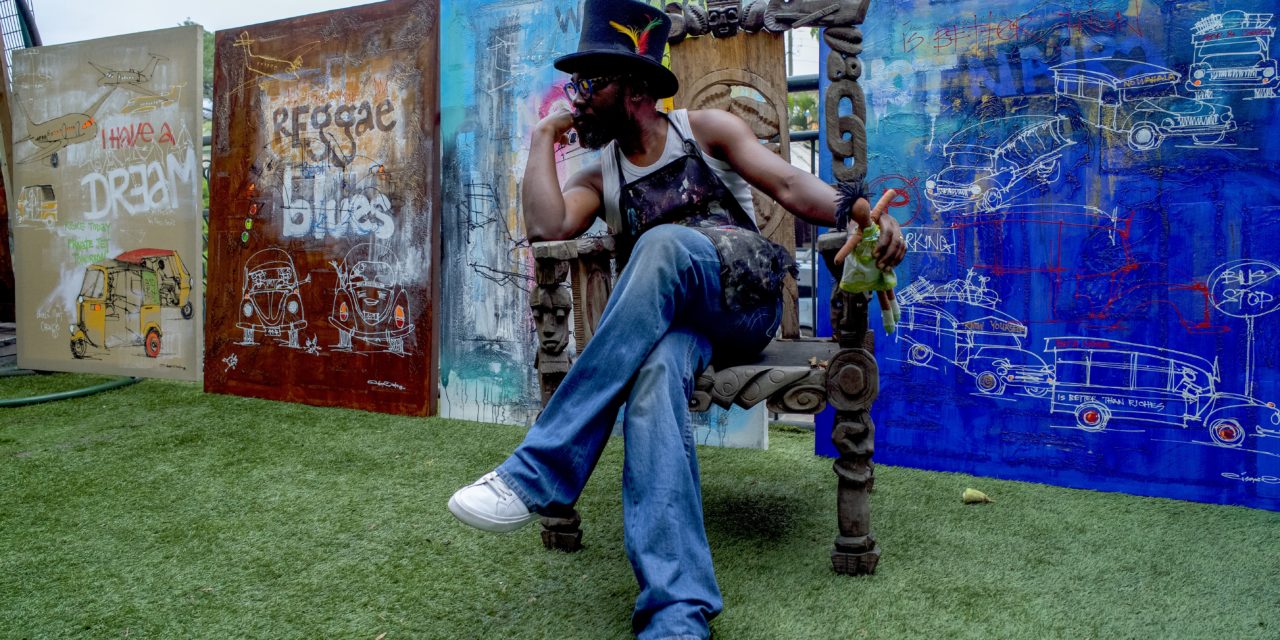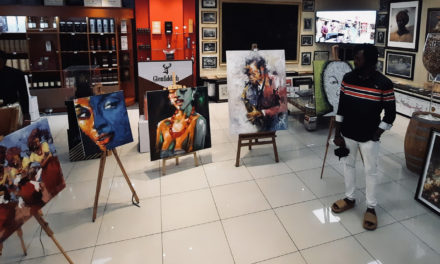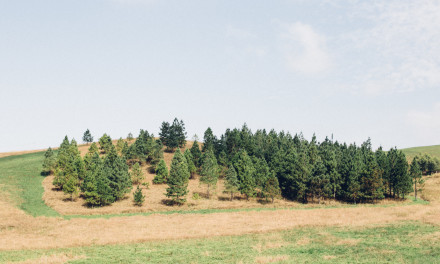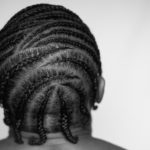AM: Are you a self-taught artist or did you attend art school?
Diseye: I attended art school. But like every other artist, after art school, you still seek knowledge. I did a lot of research. I had to go to different studios, learn from people, ask questions, read more, research and all that.
AM: Do you think it’s important to go to art school? If a young artist in secondary school comes to you for advice and says he/she is interested in the arts, would you place as much importance on them going to art school or would you advise them to do things differently?
Diseye: If you want to be a fulltime artist, it is wise to attend art school for the certificate and also for the added subjects that you will be taking while there besides the creative arts lectures (sculptures, painting, art history and all); because being an artist is just not “I can draw, I can paint”. There is also the history where you learn about people who came before you so it is easy for you to know where you are going and learn from the foundations they’ve laid down; know these artists, respect these artists, celebrate these artists. Without knowing all these, you will be lost in some way.
AM: What was support from your parents, extended family and friends like?
Diseye: It was difficult to talk to my father about actually studying art; and when I did, he wasn’t happy about it because there were no clear examples of people you could say: “Daddy I want to be an artist”, and he would say “Oh like this man, or like that woman”. They saw artists as riffraffs or ne’er-do-wells. They were just doing banners and signboards or finding it difficult to live.
He was an educationist and he never liked that I wanted to be an artist. There was really no example. I don’t blame him for it really. It was difficult, yes, to cut a long story short. I finally studied fine and applied arts and with time he got to understand what it really means to be an artist; a professional artist for that matter; and he appreciated my choice.
For me now, with my status as the Vice President of Society of Nigerian Artists, and also being the past Vice Chairman, I have seen a lot of things I have to contribute to the arts and one of them is making it easy for parents today to accept arts for their children as a profession. So I’m working on a book called Artists & Studios, in which I interview artists in their studios and talk to them about how they started. The videos and pictures are there and it will make it easy for people to understand what being a professional artist is. Not a professional artist living in the UK, or in America; but living in Africa. The two places I started working in are Nigeria and Ghana; so Nigerian artists, Ghanaian artists (because my mum is Ghanaian). I’m trying to make sure it’s easy having a book-having it online; an online presence and also a hard copy book.
Like what you see there (pointing to the bookshelf): artists in China, British artists in their studios, American artists. These are different artists and these are books on them so why don’t we have one for Africa? So that is what I’m working on. It is about 60% complete. It’s been seven years. I think that will be my own contribution to the art industry.
AM: What’s your approach to your art: do you create for you, or for your audience?
Diseye: When I started out as an artist, I started as a portrait artist (what we call commercial art where you make portraits for people to make some earnings); cards, banners. At that time, there were no computers to make your prints. That was a learning process. You can even see in my work where I have stencils and write-ups, because that was my foundation. I was doing that for commercial reasons to make money to produce what I want, because art is about your art. It is when you keep pushing your art and people see, they get used to it, and then they start liking it. For you to do that; you need materials; you need to put things in place. That was what I did.
Professionally, I’ve done over 600 portraits and I have photographs of every one of them. That was how I made my first money, like a capital to start my own studio.
AM: So it has to be both?
Diseye: It has to be a combination of both commercial and personal. Aside from being an artist that does things commercially, I do interior design, I do furniture. I do all sorts of things to add to it.
AM: You did the furniture in Native Tray too.
Diseye: Yes. For me, I mix up. It is part of business. It is still art because you have to come up with something creative for it to be appreciated. You have to look at different ways of surviving and do your own art at your time. It is your financial freedom to express yourself.
AM: How do you go about creating new work, learning new skills and re-inventing yourself? What’s your approach to generating creative ideas? I think I have seen a video before where you were in your studio at night, playing music and you had a cigar.
Diseye: One has to think about what one wants. People say wait for inspiration. I don’t believe in that. I believe you should start and inspiration will come. Because while you are at it, that’s the art. I don’t see art as the finished product. I see art as that process in which the artist goes through to come up with that idea-the thinking process. People see my furniture today. It started from somewhere; mistakes, corrections. Sometimes you will sit on one and say “I wish it would have been lower, I wish it would have been like this, it could have been like that.” How can I make it more comfortable? With time you better yourself. You need to make those first mistakes; you need to accept that “I don’t mind making mistakes” to get to where you want to.
For inspiration, me? Anything. It can happen at any time. I can just wake up with an idea.
My inspiration comes from solving problems; resolving problems. When I built this house, I didn’t know much about art. I didn’t know much about architecture. I just had someone create a design and we went on with it. But when I moved in, I started realizing “Oh I can change this, I can move this here, I can do this here, I’ll prefer this, I’ll prefer that.” That is where the creative mindset starts working. You now think of structure. Once the structure is in place you can play around with the rest. To me, for inspiration, it has to be a problem solving task for it to wake it up.
AM: What currently inspires your work?
Diseye: I have been on about buses; transit: where you have write-ups on different cars, tricycles, headboards. Even in some houses in the rural areas in Ghana and Nigeria, you find people writing “Jesus is Lord”, “God bless this home”. They stencil those things on their walls. Really, that’s all pop art. It is all part of pop art.
It started where they had restaurants where they’d have somebody holding one chicken leg; have somebody dancing. They’d make some caricature on the wall (depicting these), and these are all art – art forms that started. I’m not really looking backwards to the caveman era. I’m looking at what I grew up seeing. The similarities between Ghana and Nigeria where I grew up, are those write-ups on boats, on wheelbarrows. Even now, you find those things. They are funny witty words but they all have strong meanings; very deep meanings. When you think about it, one thing can have a lot of meanings. I research those words and I use them for my work. I use them as art to teach people Pidgin English.
When I was growing up my father never allowed us speak Pidgin English. He would smack the hell out of you if you spoke Pidgin English. I’m learning Pidgin English again – trying to understand what the words mean; how to spell them, and save these short write ups.
AM: I was looking at your painting of the buses and trucks and was thinking about back in the day (well my dad’s time not mine); that’s how people travelled in the South East. They don’t exist anymore and I don’t know how many pictures exist, so your art is probably going to be how people remember that there was a time like that.
Diseye: Yea.
AM: Does it ever become easy for you?
Diseye: It gets easy at the point where like every business you establish a brand. By brand, I mean your signature as an artist. Like my father always says “a good name is better than riches.” It simply tells you that you have to hold fast to your personal name, not for people to throw it to the mud. Do things that can help people; something they can remember you by, because you can’t take money to the grave.
For me, I think when it comes to branding, you make things easy for yourself when you have been doing something for a long time and you have been consistent with what you do and you now form a brand. And with that brand, everyone knows you are not doing what you do because of money, but because you have to live up to that brand. If Coca-Cola for example drops the quality of their product today, the world will know. They have to either mark it up or stay where they are; that’s how branding works, and even with art with signature. One has to be consistent, and once you are consistent, it makes things easy for you.
Segun Aiyesan can put his price of his work at a higher price. Some people might frown on it and say “ah, this thing is too expensive O”. But when you think about it, this artist has been consistent; he has been working for long. Do you know how many downfalls he has had to get to where he is? You don’t count that work as expensive, you count all the failed experiments and all he had done to get to that level. That’s the branding.
Once you have branded yourself, the sky is your limit and it makes it easier for you as an artist.
AM: What are your thoughts on artist collectives and collaborating with other artists?
Diseye: I have collaborated with younger artists and older masters. Reasons being that when you collaborate with masters, it brings you up, it helps you get recognized and appreciated more. And when you work with younger artists, you are also helping them to build their brand, encouraging them in some way. It is an opportunity for you give back and also receive from both ends. Collaborating is good – group shows and all that; but that is for serious artists who want to grow their art because there are some people who just want to make money and there are those who are out there to grow for the future.
AM: Like a long-term outlook and a shorter outlook?
Diseye: Art is a long-term thing. For the rest of my life this is what I’ll be doing, so how can I make it better for me in my old age?
These are masters (pointing to photographs on the wall), from Bruce Onobrakpeya to Demas Nwoko. I call them my daddies. They are people that I respect and I have done things with over the years. I look up to them. I had an exhibition celebrating Demas Nwoke two years ago. He was 81 then. I had a show for him. I painted on his chairs.
I think it is very important that we celebrate, respect and pass on their knowledge to younger artists. That’s why this book I’m working on is really important for me because it will expose a lot of things the masters have been doing: Their style, their craft, and all. I am working very hard to get it done and make sure it is done properly. It is good to collaborate.




 ‘NO LICENSE FOR NONSENSE’, acrylic on canvas, 122cm x 153cm by Diseye Tantua.
‘NO LICENSE FOR NONSENSE’, acrylic on canvas, 122cm x 153cm by Diseye Tantua.












